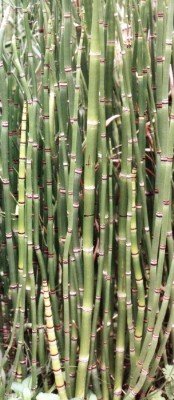Horsetail
by Valerie (May 4, 2002)
|
Members of a group that flourished before the flowering plants, horsetails are no longer a dominant feature on the landscape. Although there are only about 25 species living today, this group was a major component of the Carboniferous swamp flora. Some of those plants reached over 90 feet in height and resembled trees.
Horsetails reproduce by means of microscopic spores and alternating generations, much the same as ferns. These develop in a structure called a strobilus which forms at the top of fertile shoots. When a spore lands in hospitable conditions, it forms a tiny gametophyte, which is like a first generation. This then produces both male and female structures; the archegonia produce eggs and the antheridia produce sperm. Cross-fertilization occurs because the two structures mature at different times. Once an egg is fertilized, it produces a zygote, which then develops into a sporophyte, while the gametophyte dies. This is the generation that we see, which produces rhizomes with roots and the familiar shoots. Most of the stems that emerge from the underground rhizomes are sterile, or vegetative and simply grow a couple feet tall and come to a point on top. Because our conditions are far less than optimum for this plant, ours rarely form strobiles. The structure of the horsetail shoots is very different from many plants. Each one grows in segments which resemble soda straws stacked inside each other. There is a thin membrane between each hollow segment and the overlapping joint is brittle and dry. The stems are ribbed and quite stiff. Some species produce whorls of scaly, thin leaves that surround each joint, hence the common name. Our species sometimes just produces more stems that branch off from a joint, but mostly they are single, bare shoots. Another common name for horsetail is scouring rush. Due to high concentrations of silica crystals in the epidermis, the stems are very abrasive and have in the past been used to scour cooking utensils and polish fine furniture. Musicians who play reed instruments know this plant as reed rush and it is still sold today as a fine sandpaper substitute for the purpose of adjusting and sanding the bamboo reeds used on clarinets and saxophones. |
 There is one species, smooth horsetail (Equisetum hyemale), that lives in this area. Although it is a fairly hardy plant, it needs more moisture than our climate provides and so only occurs near water. Considered an invasive plant because of its ability to spread through underground rhizomes, we've had no problem with it because the lawn surrounding the garden in which it lives gets too little water. In fact, last year's summer was so hot and dry that I thought all our horsetails were lost. However, once the weather turned a bit more mild, several small shoots appeared. It is nowhere near its glory days, but it still survives scattered around one of our ponds.
There is one species, smooth horsetail (Equisetum hyemale), that lives in this area. Although it is a fairly hardy plant, it needs more moisture than our climate provides and so only occurs near water. Considered an invasive plant because of its ability to spread through underground rhizomes, we've had no problem with it because the lawn surrounding the garden in which it lives gets too little water. In fact, last year's summer was so hot and dry that I thought all our horsetails were lost. However, once the weather turned a bit more mild, several small shoots appeared. It is nowhere near its glory days, but it still survives scattered around one of our ponds.